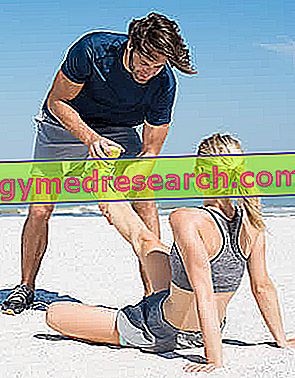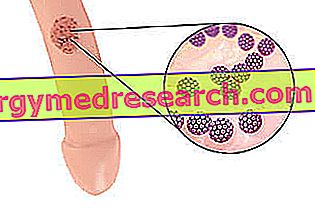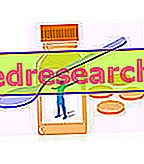By muscle cramps we mean real spasms of striated muscles. In fact, in addition to the muscle cells (partially involved), motoneurons are also responsible for the cramps.

In other words, the cramps (muscular) determine the involuntary contraction of the musculature, which instead "should" depend on the will.
The etiology of cramps is multifactorial, although their appearance does not necessarily require the co-presence of all potentially responsible factors; the most relevant are:
- Malnutrition.
- Alcoholism.
- Intense and / or prolonged physical activity carried out in hot and humid environments.
- Increase in diuresis.
- Disorders.
- Insufficient physical form for physical performance.
- Very cold temperatures.
- Taking drugs.
- Accumulation of lactic acid and other catabolites: the role of its concentration is not yet known.
We must not forget that the appearance of cramps is related to the increase in the risk of injury. In reality it is an indirect statistical link that depends above all on the low level of general training and other risk factors typical of neophytes. On the other hand, on some occasions the pain generated by the cramps can in itself remain even for several days.
Cramps can be effectively prevented; let's see how.
What to do
- Prevention: the prevention of cramps also includes most of the therapeutic interventions. It is certainly the most important measure (see under the heading Prevention). In short:
- Respect the nutritional balance of the diet and adapt it to specific needs (sports, sweating, etc.).
- Don't overeat before challenging motor activities.
- Manage sweating.
- Avoid alcohol.
- Support performance appropriate to your level of training.
- Respect recovery after efforts.
- Perform motor warm-up, cool down and stretch.
- Warm or keep the muscles warm before a performance.
- Treating diseases responsible for cramps.
- If necessary, take specific food supplements.
- At the onset of the first spasms it is generally necessary:
- Stop using the involved muscle district.
- Practice specific muscle stretching.
- Massage the affected area.
- Apply hot packs.
- Take specific supplements.
What NOT to do
- Do not adopt any preventive strategy.
- Excessive sweating (playing sports during the hottest hours, dressing excessively, using coveralls or "slimming" waistcoats).
- In case of abnormal sweating, do not use food supplements.
- Practicing ketogenic diets: they are low in carbohydrates and tend to make the muscles of glycogen "empty". This deficiency is one of the main factors responsible for the cramps. Furthermore, ketone bodies increase renal filtration, ie the excretion of water and mineral salts with urine, favoring dehydration.
- Take predisposing medications, overdose or ignore the effects:
- Diuretics: used in the clinic for the treatment of hypertension, in body building for aesthetic and sporting reasons to quickly eliminate the blood traces of the use of doping.
- Beta-2 agonists (salmeterol and salbutamol): used in the clinic for the treatment of asthma.
- Drink alcohol.
- Tackle workouts or competitions that are too demanding for your physical level.
- Schedule workouts without taking into account recovery time.
- Do not perform motor warm-up before training.
- Don't dress enough in the coldest months.
- Do not cool down.
- Do not stretch.
- Neglect or disregard diseases that can affect the onset of cramps.
- Continue with the activity despite the first cramp sensations.
- Do not stretch the muscle during the appearance of the cramp.
What to eat
- Sources of water : milk, yogurt, fresh fruit (especially summer fruits), vegetables (especially summer), fruit juices, tea and herbal teas.
- Sources of potassium : vegetables (lettuce, radicchio, carrots, artichokes, celery, onion, etc.), fruits (peaches, apples, pears, melons, watermelons, tomatoes, aubergines, courgettes, etc.), legumes (beans, chickpeas, soy, lentils, peas, etc.), whole grains (spelled, wheat, oats, rice, rye, etc.), meat (pork, beef, chicken, turkey, sheep, etc.) and fishery products (sea bream, sea bass, sardines, mackerel, prawns, octopus, cuttlefish), crab, mussels, clams etc).
- Sodium sources : mainly preserved (salted, dehydrated, in brine, etc.). The natural concentrations are much lower than the products in which it is added (tuna in brine, ham, bottarga, aged cheeses, etc.). Excellent fresh sodium sources are bivalve molluscs (mussels, clams, oysters, razor clams, etc.).
NB . Some people with very intense sweating can reduce the onset of cramps by increasing the seasoning salt (about 4g of sodium) by about 10g a day.
- Sources of magnesium : whole grains (spelled, wheat, oats, rice, rye, etc.), legumes (beans, chickpeas, soy, lentils, peas, etc.) and dried fruit (almonds, walnuts, hazelnuts, etc.). It is one of the minerals whose recommended ration is more difficult to reach with food alone.
- Sources of calcium : the main ones are cheeses, yogurt and milk. Follow the oil seeds (or dried fruit) and some legumes (some of which, however, are also rich in anti-nutritional molecules).
- Sources of B vitamins : they are numerous and contained in different foods. Some play the role of coenzyme in cellular processes, therefore they must not be missing in the diet of those suffering from cramps. It is sufficient to follow a varied diet and without exclusions of food groups (thus avoiding veganism, paleodieta etc.).
What NOT to Eat
- Alcoholic drinks: they promote dehydration and the loss of mineral salts with urine.
There are no other foods that directly favor the onset of cramps; however, the alteration of nutritional balance is implicated in their appearance.
- Low carb and ketogenic diets: diets low in carbohydrates tend to empty the energy reserves of the muscles favoring the onset of cramps. Moreover, the ketone bodies have a very relevant diuretic effect and determine the excretion of water and mineral salts with the urine. It cannot be excluded that the ketone bodies worsen the cell pH and the interstices, favoring the onset of cramps.
- Diets poor in vegetables: they are the main sources of magnesium, potassium and sodium. These last two are naturally also contained in foods of animal origin, but the portions do not allow to reach the necessary levels.
- Diets poor in water: they are mainly the nutritional regimes of those who eat outside the home and do not cook often. They contain many preserved foods, snacks, etc. Recall that foods should provide most of the water required by the body and the drinks only cover the remaining requirements. A diet rich in water (rich in fresh and slightly processed foods, partly raw) provides almost a milliliter of water per calorie of energy (for a 2000kcal diet, at least 1.5-1.8 liters of water should be contained ).
Natural Cures and Remedies
- Isotonic type hydrosaline supplements containing:
- Water: the amount must be comparable to dispersed sweat.
- Potassium: together with sodium it is the main mineral lost through sweat and urine. Regulates the excitability of muscle fibrocells.
- Calcium: abundant in the body since it is contained in the bones, in the muscles it is the ion mainly responsible for the contraction intervening directly on the actin and on the myosin (muscle proteins).
- Magnesium: it is responsible for the reversal of contraction allowing the displacement of the calcium from one side to the other of the cell.
- Sodium: together with sodium it is the main mineral eliminated with sweat and urine. It is essential to the functioning of the action potential (nerve transmission).
- Maltodextrin or vitargo: semi-complex carbohydrates necessary for a good absorption of the product and to support blood glucose, as well as muscle performance.
Pharmacological care
- The only drugs used against cramps and muscle spasms (BUT only if they become disabling) are muscle relaxants. The skeletal and smooth muscles relax. They can be oral (systemic), parenteral (injection) and topical (ointment, gel or cream); for cramps these are usually used or at most systemic ones. The most used in contractures are those that act on the central nervous system:
- Thiocolchicoside (eg Muscoril®, Miotens®): exerts its activity through a mechanism of action that involves the antagonization of the GABA-A receptor.
- Benzodiazepines also have a muscle relaxant effect, but are generally not used to treat mild symptoms such as cramps. More often, however, they are used in excessive and generalized forms of muscle contracture or fatigue.
Prevention
- Without bingeing before the performance, guarantee the nutritional contribution of:
- Water.
- Mineral salts: potassium, magnesium, calcium and sodium.
- Carbohydrates.
- Try to limit sweating or control it in relation to the time of physical activity (sports or work):
- Choose suitable training times.
- Choose a suitable technical clothing.
- Avoid alcohol abuse, which promotes kidney filtration and excretion of water and mineral salts.
- Contextualize training sessions or work activity in relation to one's level of preparation: do not exceed the volume and intensity.
- Recover enough after training.
- Perform muscle warming before performance, especially high intensity ones.
- In the winter period, adequately cover the involved muscular district to help reach the temperature.
- Perform aerobic cool-down to oxygenate muscle tissues and optimize catabolite disposal (lactic acid, ketone bodies, etc.).
- Stretch with warm muscles but not immediately after high intensity work sessions.
NB . There is no scientific basis to support the hypothesis that stretching reduces the frequency of cramps; on the other hand, since it is a beneficial activity, it is advisable to practice it anyway.
- Treating diseases potentially responsible for cramps: for some of them the appearance of cramps is only of marginal importance. Some are:
- Kidney failure.
- Chemical-physical damage to muscular sarcolemma (burns, cuts, lacerations, etc.).
- Nerve infection / inflammation.
Medical Treatments
- The only medical treatment useful in case of recurrent cramps is sports massage: this is not an activity that is necessarily linked to physiotherapy, but if you can choose it is advisable to turn to this kind of professional figure.



